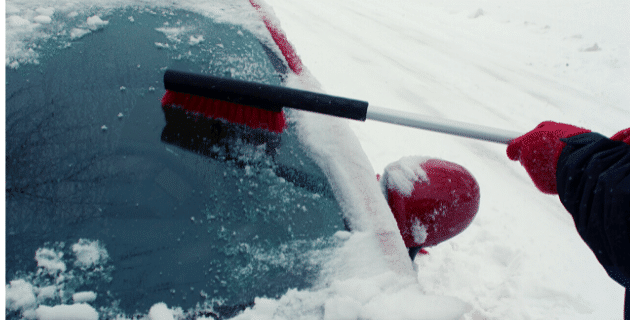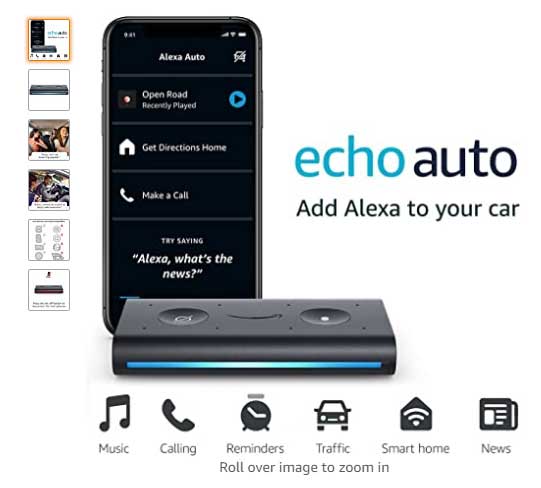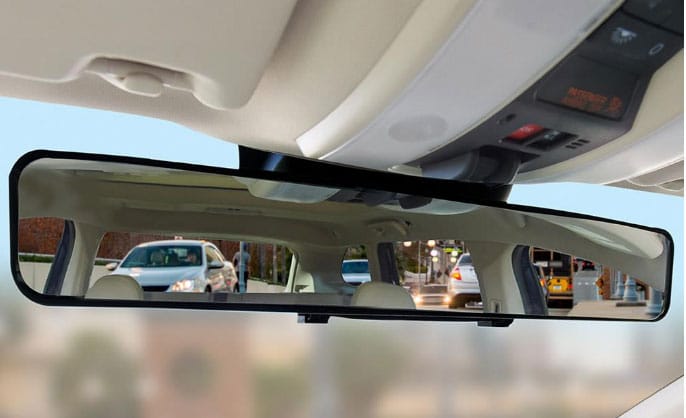
by California Casualty | Auto Insurance Info |
Winter driving presents its share of challenges, from icy road conditions to car batteries that strain due to the cold. If you live in a region where the temperatures dip down low, you could be sitting in a freezing car for hours if it breaks down.
Thankfully, some forethought and preparation can help. Make sure you’re fully prepared for whatever winter throws at you and stock up on these must-carry items for your emergency winter car kit this season.
#1: Ice scrapers, snow brushes, and a foldable shovel
It’s important to clear your whole car before you drive. Snow and ice can slide from your vehicle’s roof and obstruct your view while driving. It also could fly off and hit another car. Choose scrapers and brushes with long handles that allow you to reach the top of your vehicle. Stock several and the kids can help, too! Get a portable snow shovel too, one that folds so it takes up less space. Then use it to dig your car out as needed.
Tip: You can also use the shovel to add fresh snow or dirt around your tires to help them grip.
#2: A bag of sand or kitty litter
Your car may get stuck in the snow or be unable to move past an icy spot. Pour some sand or kitty litter over your tires and/or on the ground for extra grit to help with traction.
Tip: You can put your car’s floor mats down in front of your tires to get your car out of slippery situations. Watch the video from Firestone.
#3: Hazard triangles and LED flares
When you break down on the side of the road, you want to be seen—by other vehicles and by emergency personnel who can assist you. That’s the purpose of the hazard triangles and LED emergency flares. These are especially important when there is reduced visibility such as at night or during snowstorms.
Place the reflective hazard triangles behind your vehicle starting at 10 feet and going as far as 100 feet. Road flares have traditionally been used to mark sites for emergency responders. Rather than the traditional flares that light like a match and ignite, choose the modern version—a LED safety flare. They are designed to be waterproof, shatterproof, and crushproof and some are even magnetic and can stick right to your car.
Tip: To reduce the drain on your battery, use your car’s emergency flashers only if you hear vehicles approaching.
#4: A flashlight (and some extra batteries)
A flashlight can help you find things in the dark. It also can be used to signal passing cars. Choose an LED flashlight that offers plenty of light. If you can, pack several flashlights so that everyone in the family has one. Store batteries backward in the flashlight to prevent the light from accidentally switching on and burning out. Keep a spare set of batteries on hand just in case.
Tip: Pack some glow stick necklaces for the kids. They’re also great fun and an easy way to find everyone in the dark.
#5: Jumper cables and a battery charger
Low temperatures put an additional strain on your car’s battery. In fact, the freezing cold can turn a weak battery into a dead one overnight. If your car breaks down due to a dead battery, jumper cables can help. These cables allow you to charge your car’s battery from another car’s. You also may want to invest in a portable battery jump starter. These devices jump your battery without another car. They also can power your other devices such as cell phones or tablets.
Tip: Find out much battery life you have left with a free battery test at Firestone.
#6: A cell phone charger and portable power bank
Your cell phone is your connection to the world—and to help. Keep it as charged as possible by having a charger in your car. However, if your car doesn’t start, the car charger won’t do much good. Be sure to pack a portable battery or power bank.
Tip: If you’re stuck and your cell phone is losing power, change your outgoing message to your current location, time and date, and any other important details. That way, if your cell phone stops working, callers will get that message.
#7: Blankets and cold weather clothes
Keep a few blankets or sleeping bags in your trunk. If you want to save on room, choose pocket-size heat-reflective blankets. Then, stock some warm clothes for every member of the family: old sweatshirts, thick pants, warm socks, boots, mittens, and warm hats. Add some hand or feet warmers, which could provide much-needed warmth in an emergency.
Tip: Don’t run your car’s engine unless you are sure the exhaust pipe is free of snow. Snow can plug your vehicle’s exhaust system and cause deadly carbon monoxide gas to enter your vehicle.
#8: Snacks and water
If you’re spending any significant time in your car, you’ll want food and water. Keep water bottles and non-perishable snacks in your car through the winter. Consider these ideas: prepackaged trail mix or nuts/seeds, dried fruit, granola bars, chocolate, dry cereal, crackers, cookies, peanut butter (or other nut butters), rice cakes, pretzels. Choose kid-friendly snacks in case the kids are with you; you’ll enjoy them even if they’re not there.
Tip: For a more substantial snack, pack canned food that can be eaten cold and a can opener. Don’t forget the plastic utensils.
#9: Entertainment
Keep the kids busy with some games and activities. This will help keep them from feeling stressed and it will help pass the time. Pack a travel game bag. Include decks of cards, puzzles, coloring books and crayons or paper for older kids, and travel games. Sing songs, tell jokes, and keep the time as light-hearted as possible.
Tip: Make it a game. Take a poll on how long it will take to get home or what the tow truck driver will look like.
#10: First Aid Kit
A first aid kit is especially needed in winter because emergency response times may be longer due to icy or snowy conditions. You can buy one or make your own. Include bandages, gauze, adhesive tape, antibiotic ointment, scissors, saline solution for eye washing or cleaning wounds, aloe vera to treat minor burns, an antihistamine for allergic reactions, and anything else your family may need.
Tip: Add baby wipes, which will help if you or the kids have to go to the bathroom outdoors in nature. A garbage bag can also be a makeshift toilet if need be.
You can save some steps and buy emergency roadside safety kits that combine many of the items on this list.
Finally, should you have a winter-related accident or incident, know that your collision and comprehensive insurance will help protect you.
Safe travels.
This article is furnished by California Casualty, providing auto and home insurance to educators, law enforcement officers, firefighters, and nurses. Get a quote at 1.866.704.8614 or www.calcas.com.

by California Casualty | Good to Know, Homeowners Insurance Info |
It’s cold out there—a good time to crank up the heat or put a few logs on the fire. While you might enjoy the warmth and ambiance, winter is actually one of the worst seasons for indoor air quality. That’s because we’re nestled inside our comfortable homes along with all of the pollutants and moisture. Fun, right?
Our chances of catching a cold are greater during the winter, especially if our home’s air quality is poor. In addition, trapped pollutants increase our risk of asthma and other respiratory problems. The good news is that we can do something about it! According to the Environmental Protection Agency (EPA), there are 3 basic strategies for better indoor air quality: (1) controlling sources of pollutants (2) improving ventilation, and (3) cleaning the air. Here’s what you need to know to improve your indoor air quality this winter.
Source Control
There are many sources of indoor pollution, ranging from fuel-burning appliances to building materials and furnishings, and even household cleaning products. Take a look around your house to identify the sources of poor indoor air quality, so that you can take steps to reduce their impact.
Airborne chemicals
Also known as VOCS – volatile organic compounds – these “hang” in the air for us to breathe. Scented air fresheners, cleaning products, paint, and even carpets and furniture release chemicals in the air. VOCs can cause health problems from respiratory illnesses to headaches, dizziness, irritation in the eyes, ears, nose, and throat, and more. You can choose low VOC paint, or repurposed/upcycled furniture to reduce some chemicals, and use natural cleaning products.
Tip: A bowl of vinegar with lemon juice will draw out bad smells. Baking soda and lemon juice also absorb odors.
Carbon dioxide
During the winter months, we’re gathered together indoors, which means we’re breathing in close proximity to each other. As carbon dioxide levels rise, that can cause headaches, drowsiness, and other problems. If the levels get high enough, it can even impact decision-making. Limit candle lighting and fireplace use which can contribute to carbon dioxide levels. Open a window for a few minutes, even if it’s cold, to let the fresh air in.
Tip: Add plants like red-edged dracaena, weeping figs or bamboo palm to help convert CO2 to oxygen.
Radon gas
When our doors and windows are shut, it’s easy for radon gas to build up. Radon gas comes from the natural decay of soil. It moves into your home through cracks or even through your water supply. While it may be natural, radon is radioactive and dangerous. It’s the number one cause of lung cancer among nonsmokers. A radon test kit can measure your home’s levels. The EPA offers guidance on radon reduction systems.
Tip: Most states can provide a list of qualified radon service providers. Find more information at https://www.epa.gov/radon/epa-map-radon-zones-and-supplemental-information.
Level of humidity
Air that is too dry – or too moist – can cause problems. The dry air in winter causes dry skin, chapped lips, dry nose, dry throat, and cracked fingertips. High humidity causes mold and condensation which also can affect our health. The ideal level for household humidity should be between 30% and 59%. You can buy an inexpensive monitor to track your household humidity. To help reduce it, use your exhaust and ventilation fans, take cooler showers, or consider a dehumidifier. UV lamps professionally installed in your HVAC system can help kill harmful bacteria and mold before they enter the air supply.
Tip: Run your air conditioner. It may be winter, but your air conditioner can help clear humidity from your home.
Fireplaces
The seasonal scent of wood-burning fireplaces may be wonderful, but that smoke is adding fine particles of dust, dirt, and liquids to the air. Choose clean-burning logs to reduce the effects, and never use wood that is wet, painted, or treated. Gas fireplaces that are vented to the outdoors are better for air quality.
Tip: Warm your chimney flue before starting the fire to help it draw smoke upwards and out of your home.
Dust and dirt
Dust and dirt are respiratory irritants and frequent cleaning can help. Dust and clean your home regularly. Take cushions and rugs outside and beat them to loosen and get rid of dirt. Then wipe them clean with a damp rag to pick up any additional particles and mites. Vacuum rugs and carpets using a vacuum cleaner with a high-efficiency particulate air (HEPA) filter.
Tip: A bristle top doormat helps to trap dirt before it comes into your home. Wash or vacuum your mats regularly to prevent buildup.
Pets
We love our pets but pet hair and dander can affect indoor air quality, especially for those of us who are sensitive or allergic. Air filters and ventilation can help. (See next sections.) Brush your pet regularly to reduce the amount of shedding. Keep a towel by the door and wipe their feet to prevent them from bringing additional dirt into the house.
Tip: Use a window squeegee on your carpet to pick up pet hair. The rubber will loosen the hair and gather it into clumps.
Improved Ventilation
Your HVAC system is your home’s first line of defense against airborne particles. Make sure your system is well maintained and your ducts are cleaned. You also can upgrade the air filters in your HVAC system to a higher MERV rating, if your system allows it. This will increase their ability to remove particles, germs, viruses, and chemical gases. Check with an HVAC professional.
Ventilation devices help air circulation that keeps indoor air clean. They typically are installed in a home’s attic or roof and bring in fresh air on a regular basis while expelling stale air.
Air Cleaners
There are many types of air cleaners for home use, ranging from table-top models to expensive systems for the whole house. An air purifier with a HEPA filter can remove anywhere between 70-95% of airborne particles. Consider buying an air cleaner for each room. Choose one with smart sensors that can detect pollutants in real-time and adjust their fans accordingly.
In addition, you may consider an indoor air quality monitor. These devices can monitor levels of moisture and pollutants, and share information on which part of the house is contributing to poor air quality.
Your home is your greatest investment. Protect it as well with the right home owner’s insurance.
This article is furnished by California Casualty, providing auto and home insurance to educators, law enforcement officers, firefighters, and nurses. Get a quote at 1.866.704.8614 or www.calcas.com.

by California Casualty | Auto Insurance Info |
We’ve all got that one person in our lives who absolutely lives for cars. Their knowledge can rival any Google search. And don’t even get them started about a certain body style or engine, or they’ll never stop. To them their car isn’t just a car; it’s their baby.
If you’ve got one of these folks on your gift list, you’re in luck! Whether it’s the latest tech toy or the unusual find, we’ve got the best gifts for all car enthusiasts below.

Hi-tech Gear
The car may be the centerpiece but these hi-tech additions can make a sweet ride even sweeter!
- Amazon Echo Auto puts Alexa right in your car. The device connects to the Alexa app on your phone and plays through your car’s speakers. Alexa can play music, make calls, find a nearby coffee shop, pay for gas, all at the command of your voice. It doesn’t work with all car models or smartphones, so check before you buy.
- NOCO’s Portable Battery Jump Starter Pack offers peace of mind if you ever need an extra charge. It’s also an LED flashlight and a portable power bank for USB devices. This booster is rated for gasoline engines up to 6 liters and diesel up to 3 liters.
- The Garmin Dash Cam Mini 2 alerts you if there’s an incident around your car and automatically records it. It provides video if you’re ever in an accident. This device is prohibited in some areas; make sure you’re aware of the local laws.
- The Car Cushion with Massage and Heat from Sharper Image offers comfort and warmth for those long, cold winter drives—and even the short ones!

Car Inspired Fashion
These trendsetters are a must for car lovers when they aren’t behind the wheel.
- Puma has a line of motorsport sneakers that celebrate such carmakers as Porsche, BMW, and Ferrari. With logos and team colors, these kicks are perfect for life in the fast lane. Pair them with Heel Tread socks, inspired by classic car brands.
- Driving gloves are not only a stylish accessory. They give you a firmer grip on the wheel and they keep the wheel from getting dirty or sticky.
- From t-shirts with classic Corvettes to funny ones that proclaim “still plays with cars,” Zazzle has some great options.
- Speedometer and fuel gauge cufflinks are the perfect accessories for any dress-up occasion.

Practical – and Fun
Check out these fun and useful ideas for the car lover in your life.
- Etsy has some wonderful presents for car lovers. If you’re looking to open a little bubbly this holiday season, the spark plug bottle opener is the perfect gift. Or try these car coaster cup holders that keep those pesky places clean from dirt and debris. For the car-loving dad in your life, this key chain says it all.
- The No Blindspot Rearview Mirror was rated the best by the Hammacher Schlemmer Institute. It offers a 180-degree view with no distortion, and clips right over most existing rearview mirrors.
- The Gillette Heated Razor Bugatti Limited Edition pays homage to the iconic Bugatti. Plus, this razor heats up, delivering a shave that’s as luxurious as the car!
- Teachers, give a special gift by extending your NEA Member Benefits to eligible family members. NEA Member Benefits recently added siblings to the list of family members eligible to access the NEA Auto and Home Insurance Program provided by California Casualty. Parents, in-laws, adult children, and now siblings can take advantage of the special rates, deep discounts, and personalized service available through the NEA Auto and Home Insurance Program.

Just for Fun!
Put a smile on every car lover’s face this season with these uniquely fun gifts.
- LEGO® isn’t just for kids. The toymaker has an extensive line of car kits for adults. This includes the LEGO® Technic Lamborghini Sian FKP 37 and the James Bond™ Aston Martin DB5. Let the car lovers in your life build their dream car collection.
- For the gamer in your family, the Logitech G920 Racing Wheel offers a great “driving” experience. It realistically simulates the feel of your car and tires on every turn.
- When you can’t get enough of your car, a custom watercolor print is just the thing! You can also find beautiful car wall art on Fine Art America.
- For the ultimate gift, give your car lover a ride in a race car. Virgin Experience, Xtreme Experience , and others offer chances to drive tracks throughout the U.S. Also check Groupon for local listings of exotic car rides or rentals in your area.
Happy holidays from California Casualty!
This article is furnished by California Casualty, providing auto and home insurance to educators, law enforcement officers, firefighters, and nurses. Get a quote at 1.866.704.8614 or www.calcas.com.

by California Casualty | Homeowners Insurance Info |
It’s the holidays and if you’re like most Americans, you’re pulling out the extension cords. Whether you’re planning a fantastic holiday light display or you simply need to power an extra item or two, remember that safety is key.
Extension cords are responsible for about 3,300 home fires annually, including holiday fires, killing 50 and injuring 270 people each year, according to the Electrical Safety Foundation International. That’s why it’s important to know how to choose and use these cords safely.
Follow these tips for extension cord safety this holiday season.
When buying extension cords, consider these important factors.
-
- Select a cord that is approved by an independent testing lab such as Underwriters Laboratories (UL), Intertek (ETL), or CSA-International (CSA).
- Choose a cord with a 3-prong plug and if possible, a polarized one. Polarized plugs can only be inserted into an outlet one direction, because the blade on one side is wider than the other.
- If you’ll be using the cord outside, choose one marked for outdoor use. Outdoor extension cords have more insulation, which protects them from varying temperatures, sunlight, and unintentional scrapes.
- Select a cord that is long enough for your needs. Never plug an extension cord into another extension cord to extend it. That’s not safe.
- Know what you are powering and choose a cord that can provide the right load amount. If you buy one with insufficient power for your needs, you could overheat it and cause an electrical short or a fire.
- The thickness of the cord will be a clue to its power. Small appliances and electronics can use thin or flat cords. Larger ones need thick, round, low-gauge cords able to handle a higher amperage/watt flow. The amperage is the measure of electrical current flow. The wattage is the amount of electrical power of an appliance or lamp.
- Look at the label on the cord and match it to your electrical needs. If you’re unsure, ask for help from the retailer.
- Length makes a difference. The longer the cord, the more chance for voltage to drop. If you’re running a 50-foot cord, select a higher rating to account for that loss.
When using extension cords, remember these do’s and don’ts.
Don’t…
… power multiple appliances with one cord.
… remove the third prong from your plug to fit in a 2-prong outlet. That could open the way for a nasty electrical shock.
… run cords under rugs or furniture. If the heat has nowhere to escape, it could cause a fire
… tape cords to floors or attach them with staples or nails, which could compromise the wiring.
… bend or coil extension cords that are in use.
… put cords across highly trafficked areas. They can be a tripping hazard.
… plug extension cords into power strips that are then plugged into outlets. This presents a similar danger to plugging extension cords into other extension cords—and heightens the risk of a fire.
… don’t use extension cords with heaters or fans. The risk of overheating is too great.
… don’t use extension cords that feel hot to the touch.
Do…
… check for frays, loose wires, and other damage. If you see any, throw out the cord and use another.
… insert prongs fully so no part of the metal is exposed while the extension cord is in use.
… cover unused cord receptacles with childproof covers.
… keep pets away from extension cords. Spray the cord with Bitter Apple to discourage chewing.
… pull the plug – and not the cord — when disconnecting from the socket. Pulling the cord could damage the wire and also present a shock hazard.
… store cords indoors and throw away damaged cords.
Remember that extension cords are designed to be temporary. If you’re using them on a permanent basis, it may be time to update your home’s electrical system.
Finally…a word about power strips
Power strips add extra outlets when you need them. That doesn’t mean you should use every outlet in the strip. Just like extension cords, power strips have electrical load limits. Check the rating, and make sure your power strip includes a built-in surge protector. These protect from a spike in electric current that can damage your electronics or appliances.
The personal property coverage in your homeowner’s insurance may cover damages from a power surge or electrical fire. Check with your insurer.
This article is furnished by California Casualty, providing auto and home insurance to educators, law enforcement officers, firefighters, and nurses. Get a quote at 1.866.704.8614 or www.calcas.com.

by California Casualty | Homeowners Insurance Info, Pets |
You came home to a rug that’s been chewed to shreds and a mess on the carpet—again. Now your house is smelling (and looking) a bit like a kennel… You love your dog, so you’re thinking it may be time to scrap the carpet altogether.
But think twice before you make any rash decisions. Carpets have so many advantages for your home! They muffle noise. Dogs won’t slip and slide on them like they can on hard surfaces. You also don’t have to worry about their claws scratching your hardwood floor. Plus, carpets are a soft place for your feet and for their paws.
The good news is that dogs and carpets can actually coexist nicely. Here’s what you need to know.
Choose the right carpet.
Not all carpets are the same when it comes to protecting against pet stains and messes. Look for carpets made of nylon, wool, or a material known as olefin. The most popular option, nylon is durable and easy to clean. It also has built-in stain resistance. Wool, the more expensive option, has some natural stain resistance but cannot be treated with a stain-resistant coating. Olefin was originally used in outdoor carpets but has been engineered to have more of the feel of wool. It’s made from plastic fibers, is easy to clean, and repels moisture.
Take care of new messes right away.
Cleaning up after your pet is part of being a responsible pet owner. The best way to keep your carpet from staining is to address your pet’s accidents right away. If you use a store-bought cleaner, choose one with a neutral pH to help remove the acidity of your pet’s urine. You can also make your own cleaning solution from vinegar, baking soda, and water. Here are two natural methods for cleaning up pet urine on carpet.
Method #1
-
- Place a thick layer of paper towels over the wet spot.
- Cover the towels with layers of newspaper.
- Stand on the newspaper for a few minutes for it to absorb the urine.
- Remove the paper and paper towels and dispose of them.
- Rinse the area with cool water.
- Blot up the water with towels. If you have a wet vac, you can use that instead.
- Once most of the liquid is blotted, spread baking soda over it. Use ¼ cup or less. (Note that large amounts of baking soda are toxic to dogs so keep your fur baby away.)
- Let the mixture sit overnight and then vacuum the spot thoroughly the next morning. The area should feel clean to the touch.
Method #2
-
- In a clear spray bottle, mix one cup of distilled white vinegar with one cup of water and 2 teaspoons of baking soda. Shake it up.
- Spray the mixture on the stain.
- Let it sit for a few minutes and then blot it with a towel until clean.
You can use these methods for other pet messes such as vomit or poop. Remove the vomit or feces before treating the carpet, being careful not to embed it in the carpet fibers. Act quickly; the acid in vomit can quickly discolor your carpet.
Take care of old stains, too.
Old urine stains can cause a lingering odor in your home. You can take care of these stains in several ways. One way is to use an enzymatic cleanser that breaks down the stain at the molecular level. You can find these cleansers at pet stores. Another way is to rinse the area thoroughly with water, then use a wet-dry vacuum to clean it up. Importantly, do not use a steam cleaner. The heat can set the odor and stain permanently.
Not sure where the stains are? A blacklight can help you find them. The wavelengths of blacklight cause the proteins in urine to glow.
Add a carpet runner to high-traffic areas.
Consider a carpet runner or area rug over your wall-to-wall carpeting for an extra barrier. Place it in high-traffic areas or where your dog commonly goes. Carpet runners and area rugs may be picked up and cleaned, and more easily replaced, if needed.
Clean their paws and clean your carpet.
There’s a lot of preventive care that you can take to keep your carpets clean. Start by wiping and drying your dog’s paws when your fur baby comes in from outside—especially on rainy, snowy, or muddy days. Then, take care of your carpet by vacuuming regularly and shampooing your carpet every 12 months to remove dirt, grime, and allergens. You can schedule a professional carpet cleaning or do it yourself.
Train your pet.
When you adopted your pet, you made the commitment to stick with them through the good and the bad. Oftentimes bad behavior like going to the bathroom on the carpet can be un-trained. You can do this by kennel training when you are gone or using a reward method when they go outside. If you need help, talk to your pet’s veterinarian for ways you can teach your pet to unlearn these behaviors or find a local trainer! You may think you are doing them a favor by not disciplining them when they make a mess or start chewing on furniture, but really you are getting in the way of the great pet they have the potential of becoming- by not letting them learn that these behaviors are ‘bad’.
Keep in mind the age of your pet plays a factor. A puppy or an older dog may need extra attention and may have more accidents than a dog in its prime.
Does homeowner’s insurance cover damage from your pets?
Unfortunately, homeowner’s and renter’s insurance both do not cover the damage your pet does to your carpet—or to any of your personal property. Take note that even your carpet warranty probably does not cover pet damage. If your pet, however, gets loose and damages property at your neighbor’s, the liability coverage in your homeowner’s policy may kick in and cover some of the costs.
This article is furnished by California Casualty, providing auto and home insurance to educators, law enforcement officers, firefighters, and nurses. Get a quote at 1.866.704.8614 or www.calcas.com.









